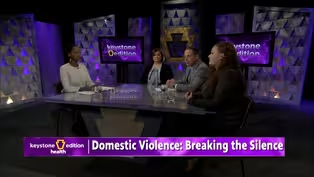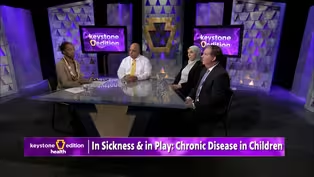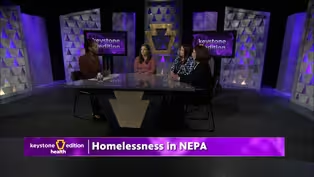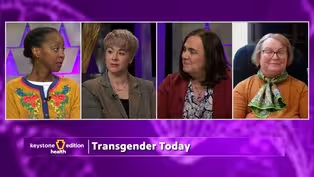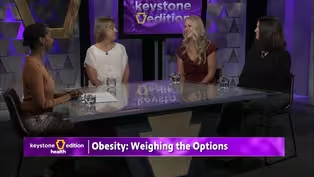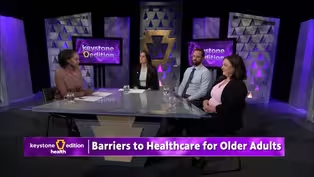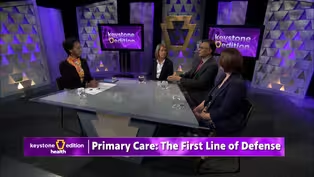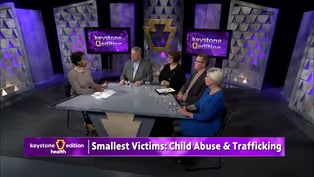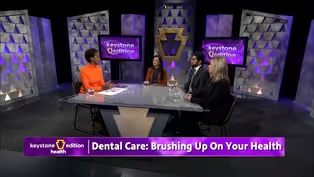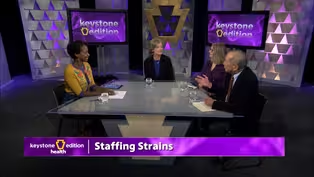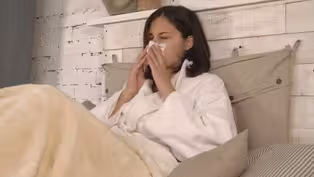Keystone Edition
Under the Weather? Climate Change & Your Health
4/24/2023 | 54m 59sVideo has Closed Captions
How does climate change impact individual and public health?
It's hard to deny the climate is changing. Summers are getting hotter, sometimes to dangerous degrees, and catastrophic weather events have become more frequent throughout the country. But how else does climate change impact individual and public health?
Problems playing video? | Closed Captioning Feedback
Problems playing video? | Closed Captioning Feedback
Keystone Edition is a local public television program presented by WVIA
Keystone Edition
Under the Weather? Climate Change & Your Health
4/24/2023 | 54m 59sVideo has Closed Captions
It's hard to deny the climate is changing. Summers are getting hotter, sometimes to dangerous degrees, and catastrophic weather events have become more frequent throughout the country. But how else does climate change impact individual and public health?
Problems playing video? | Closed Captioning Feedback
How to Watch Keystone Edition
Keystone Edition is available to stream on pbs.org and the free PBS App, available on iPhone, Apple TV, Android TV, Android smartphones, Amazon Fire TV, Amazon Fire Tablet, Roku, Samsung Smart TV, and Vizio.
Providing Support for PBS.org
Learn Moreabout PBS online sponsorshipMore from This Collection
Healthcare is constantly changing as technology finds new and better ways to help people live longer, healthier lives. Host Tonyehn Verkitus will address the issues that are important to the people in our community, including the ongoing pandemic, concerns about vaccines, food deserts, childhood trauma and child abuse, mental health, environmental issues, and the rising cost of staying healthy wit
Domestic Violence: Breaking the Silence
Video has Closed Captions
Access to the right resources can make facing this challenge a little easier for families (26m 59s)
In Sickness and in Play: Chronic Disease in Children
Video has Closed Captions
About 25% of children in the US aged 2 to 8 years have a chronic health condition (27m)
Video has Closed Captions
Homelessness can happen to anyone at any age or socio-economic status. (26m 59s)
Video has Closed Captions
As we raise the visibility on Transgender young adults and embrace them within our culture (26m 59s)
Video has Closed Captions
Obesity is a serious risk factor many try to avoid when developing healthy eating habits. (27m)
School Nurses: Answering the Call
Video has Closed Captions
What can our school districts do to help retain and recruit nurses for future generations? (27m)
Barriers to Healthcare of Older Adults
Video has Closed Captions
What progress have local organizations made in addressing these challenges? (27m)
Primary Care: The First Line of Defense
Video has Closed Captions
When was the last time you saw your primary care doctor? (27m)
The Smallest Victims: Child Abuse & Trafficking
Video has Closed Captions
What are the signs to know to spot child abuse and even possible trafficking? (27m)
Dental Care: Brushing Up on Your Health
Video has Closed Captions
How can providers make dental care more affordable and accessible? (26m 59s)
Video has Closed Captions
What does the cannabis industry mean for Northeastern and Central Pennsylvania? (26m 59s)
Video has Closed Captions
Low staffing levels can lead to burnout among healthcare workers (27m)
Providing Support for PBS.org
Learn Moreabout PBS online sponsorship- [Narrator] Live from the McHale Athletic Center on the campus of Wilkes University, WVIA Presents Keystone Edition Health, a public affairs program that goes beyond the headlines to address issues in Northeastern and central Pennsylvania.
This is Keystone Edition Health and now moderator Tonyehn Verkitus.
- Good evening and welcome to Keystone Edition Health, live from the McHale Athletic Center at Wilkes University.
I'm Tonyehn Verkitus, thank you for joining us.
Tonight we're taking a look at something you may already be feeling the effects of, climate change, as climate change accelerates, it's becoming harder to deny.
Our summers are getting hotter.
Catastrophic weather events are becoming more common and the widespread impacts of climate change can even make things like seasonal allergies more common.
Our panel of experts is here to shed some light on how climate change is impacting our health.
They're also ready to answer questions from our live audience, if you have questions, step up to the microphone at any time.
Now let's meet our panel.
Dr. Matthew Finkenbinder is Associate Professor of Geology here at Wilkes University.
From Keystone College we have Dr. Vicki Stanavitch, associate Professor of Biology and public health, and Dr. Ned Fetcher, project coordinator for the Institute of Environmental Sustainability here at Wilkes.
Thank you all for joining us tonight.
I think it's very apropos that we're having this conversation, given that we just celebrated Earth Day, so thanks for being here.
I think just to start it off, it would be helpful to just have some basic understanding about climate change.
Matt, do you think you could tell us a little bit about climate change, is it the same as global warming?
- Sure, good question.
So we use the term climate change to discuss and talk about long-term weather changes.
So what instrumental data show recently globally is that temperatures have increased, and so we have, you know, used this term, global warming, to describe that.
What we know though is that climate is variable across space and time.
And so we're kind of more so using the term climate change now, because the magnitude of warming isn't the same everywhere.
One example of that is the Arctic, near the polar regions, we see more warming there.
The rates of warming are greater there, because there's more snow.
And so when that snow melts, we have more energy being absorbed and that's causing more rapid warming in that particular region.
- And is climate the same as weather?
- Another good question, yeah.
So they are often confused or they can be confused, and so we think of weather as, you know, the instantaneous state of the atmosphere.
We're talking about the temperature rate now or the precipitation now, that's hours, minutes, days, weeks.
Climate is the long term average of weather.
And so we need typically at least 30 years of data to calculate climate averages.
- And Vicki you're an epidemiologists, so you're thinking about how climate affects health, but first can you explain to us what an epidemiologist is?
- Sure.
Epidemiologists really can look for risk factors, cause effect relationships between, you know, whatever it is that you're studying.
So you can look at climate and health as one cause effect type of relationship.
I do infectious diseases, so I'm usually looking at, you know, what disease caused this outbreak and you know, what can we do to prevent that from spreading within a population.
- When we spoke, we did talk a little bit about waterborne illness.
Can you tell us how climate is affecting water or impacting and increasing waterborne illnesses?
- Sure so (Vicki laughing) another good question, right?
Absolutely.
So when you're talking about waterborne illnesses, first of all, the increase in temperature makes the water warmer, so the organisms are able to grow and reproduce faster, easier and so that they're present, but really where the effect comes in is when you have extreme weather events.
So you have flooding and then these organisms are able to spread from where they are normally found into other areas where drinkable water is.
They can get into the water table and they can cause, you know, diseases spread from where they would normally be located.
So, you know, it's the extreme, the heat and the extreme weather with the flooding and the increased precipitation that actually ends up leading to spread of a waterborne illness.
- Can you tell us what some common waterborne illnesses are?
And I'm sure there's probably some we've never even heard of, if you might wanna touch on that as well.
- Sure, in this area, so I kind of thought I would focus more on what you would come in contact here.
So Giardiasis or Giardia Lamblia is one organism that's, you know, common in our water waste to begin with and can cause disease than if it gets into humans or animals.
Another, I mean, E. coli, we, people have heard of E. Coli but that's less common actually as waterborne illness in this particular area.
You might see that where, you know, flooding occurs where a sewage treatment plant spills over into the waterways.
You might then see that because E. coli is found in the intestinal tract of people and animals, but that's less common than Giardia in this particular area.
If you're talking globally, you're looking at things like cholera, typhoid, right?
The organisms that cause that are waterborne diseases.
- And who's most affected or at risk for waterborne illness?
- So sadly, it becomes an equity issue, right?
Because those populations that are most at risk are also, they have less access to clean water, they have less access to health care, they have, you know, so poorer populations, older populations, young children are, you know, can be devastated by contracting a waterborne illness.
So it's, you know, becomes equity in that the poorer populations are the ones most affected by waterborne diseases.
- And we've seen this obviously before with things like Katrina, where certain neighborhoods were flooding while others were not.
- Yes, absolutely.
Just look at, you know, I know the Flint, Michigan water crisis is not a waterborne illness, but the opportunity is available in those types of environments for waterborne illnesses then to spread.
So absolutely.
- [Ned] Can I add something?
- [Tonyehn] Yes.
- So I spent a couple of years in the Peace Corps in Nepal, and I had most of those diseases that you listed, including Giardia, anemic dysentery, and some other.
So it's, again, it's a water quality issue and everybody here should be very thankful for modern plumbing and modern sewage systems.
Absolutely.
Matt, can you tell us a little bit about paleo climatology and how your looking at climate change effects while you're doing your work?
- Sure, yeah, so I'm a geologist, but my background is paleo climatology, so that's a field within the geosciences where we look at reconstructing climate going back in time before we had in situ measurements, before thermometers or rain gauges existed.
And so what we focus on collectively is paleo climate archives.
And so these are natural materials that either accumulate or grow over time and as they accumulate or grow, they record some aspect of the local environmental or climate conditions.
And what I do is focus on lake sediments.
And so that's basically the muck that accumulates in the bottom of lakes and over time that produces a layered archive of climate.
And so really the objective of this field is to reconstruct climate going back, let's say before the 18 hundreds.
And that's really important because it gives us a geological perspective of climate and it helps us understand how climate varied and what really drove climate conditions before people had a measurable effect on climate.
- [Tonyehn] And I know you're doing some research, how exactly are you doing this research?
- Yeah, so I have, I work at, all over North America, so for the most part in high latitude regions.
So I work in Alaska on lake sediment records, many parts of Canada, British Columbia, Alberta, Manitoba, Ontario, and Newfoundland, I'm missing a couple provinces there.
And then closer to home in northeast PA.
So we've got lakes here and my students and I and colleagues are working on a number of projects to look at how climate changed over the last 15, 20,000 years, recently looking at, so glacial cycles.
So trying to understand the kind of natural rhythm of glacial cycles and determining the timing of those transitions.
And that's really important because right now we're in a time period where climate's, the earth temperature is increasing, ice sheets and glaciers are melting, that's causing sea level rise.
And so what many paleo scientists are focusing on is past ice house periods or glacial periods where the same things happen that's happening now.
And potentially if we learn something about past variations, that'll help us understand what could happen moving forward.
- So you're saying that this could potentially be cyclical, but do you think it's longer periods happening now?
- Yeah, a good question there.
So to kinda add to that, you know, prior to the 18 hundreds when fossil fuel combustion really ramped up, then climate was driven solely by natural factors.
So things like the very slow movement of tectonic plates that happens on million year time scales.
Then we have orbital scale changes in climate, which involves changes in earth's orbit around the sun and the tilt angle as the earth spins on its axis, that's on, let's say tens of thousands of year time scales.
And then when we get kind of closer to now, then we have things like the sun and solar output variability or volcanic eruptions.
And certainly we have to account for those in the paleo studies.
More recently in time though, what we see is that humans in their fossil fuel combustion and land use change has dramatically increased greenhouse gas levels.
And so that is now, what we see now is affected by both natural factors, but also those human factors.
So the paleo studies really help us understand what happened before and what was driving that.
And even though we have human influence now, that can still help us understand potentially what could happen moving forward.
- Ned, can we talk a little bit about your work that you're doing with phenology?
- Yes.
So phenology is a term for the sort of changes that plants or animals go through in the course of a season.
So right now at spring, leaves are coming out, that's a phenological event.
Sometime later, there may be flowers or seeds.
Those are also phenological events and finally in the fall, leaves will drop and that's another phenological event that we call senescence.
So we are studying the phenology of arctic plants, most specifically this plant here called cotton grass.
And it forms this tussock growth form, it's a sedge and there are millions of these scattered all over northern Alaska.
It covers an area about the size of Florida, north of the Brooks Range, sort of between the Brooks Range and Prudhoe Bay.
And so this plant, we have shipped it down here, it's been growing in the greenhouse since last summer.
I can pick it up and show it like that.
So we, what happens is that we've been studying how this plant greens up and then we've also been studying the controls that cause it to senesce and part of those controls might be temperature, and certainly when it gets cold, we see it in August.
These things start to senesce in August.
But then also the other control might be light.
And so we're concerned about how the light regime periods of light and darkness interact with the temperature to cause senescence in these plants.
This is another one, the same species, and this one comes from Wayne County.
It's the same species and you can see that it's a little bit taller.
So this represents a different population from the one from Northern Alaska.
And so one of the things we're concerned about is how different populations of plants respond to changes in temperature and changes in light regime.
Because one of the things that we're working on is as the temperature warms, there's could be a mismatch between the climate that plants are adapted to and the climate that they are now encountering so that there is a mismatch and the result is that they may not perform as well, they may not grow as well.
And then there's a possibility that they can be overtaken or replaced by other species.
- So as you're monitoring these changes, it's telling you how climate is changing, but then you're also potentially looking for adaptations within the plants?
- Yes, yes.
Well, we're, yes, we're looking for adaptations and we're monitoring the adaptations in different ways.
One is through experimental observations and then I have a colleague at the University of Texas, El Paso, who's also looking at the changes that are happening at the molecular level inside these plants.
- Thank you.
Students at Keystone College have the opportunity to see the impact of climate change can have on the environment firsthand, we visited Dr. Robert Cook at the Woodlands campus to find out more.
- The most recent intergovernmental panel in climate change report that came out in March of this year looked at the impacts of climate change on health, the impact of climate change on food production, where you have areas of food scarcity today, those areas are predicted to become drier and food resources are going to be more limited and that nutritional needs of people don't change with climate and so there's a dire impact to the health of the already marginalized populations, increased morbidity and mortality due to extreme climate events, hurricanes, droughts, one of the sort of underreported, but most severe impacts on human health are heat waves.
Every one of those puts a stress on the individual, economic stresses due to crop failures.
The stresses due to displacement of peoples, we're already seeing immigration that's climate change driven.
And then of course the traumatic effects of extreme weather events and all of those impact mental health.
Allergies kill me, if you could hear my voice now, you know I'm very much aware of the effects of climate on allergens, yeah, plants thrive on CO2 and with increased CO2, we're seeing greater abundance of plants that are producing more and more pollen.
We're encountering more and more ticks it seems.
And those changes are driven by more mild winters.
You don't get as much kill off of the tick population and also greater populations of the deer and mice that serve as hosts for those ticks, those are climate related events.
If a student is engaged in a first person narrative with nature, that really facilitates learning about nature but also respecting it, we have a course that's called Global Change.
So the students get an understanding of the basic science behind climate change and the most recent data.
And then we also have an environmental ethics course where the students consider the duties that we have to our citizens and to the citizens of the rest of the world due to climate change that we are the leading contributors to.
- Vicki your colleague here mentioned weather extremes and ticks, which I think would be a great transition to talk about vector borne illnesses.
- Of course.
- First of all, I'm not sure that most people understand what vector borne means, so if you could describe that for us.
- Sure, absolutely.
So a vector borne disease is where the disease agent is carried from the normal place it's found in nature to a human host or an animal host.
So in this particular case, we're talking about mosquito-borne illnesses 'cause the mosquito serves as the vector, tick-borne illnesses, you know, some fleas can carry disease, sand flies.
So there's a wide variety of insect vectors that can carry disease from one organism to another.
- And how was the climate increasing this transference of vector-borne diseases?
- So yeah, absolutely.
That's a really great question.
There's a couple of different ways, so first of all, the temperature, right, as we expand, as it gets warmer earlier in the spring, these organisms are able to hatch earlier.
And so we expand the opportunity for them to bite someone and transfer a disease.
But on the, you know, the other side of that, the changing in, you know, habitat is increasing.
So for example, Lyme disease specifically, so the tick that carries Lyme disease and the mouse that is the normal, natural host for the bacteria, they're expanding their habitat as weather patterns change and it's warmer for longer periods of time.
So it used to be only 14 US states had cases of Lyme disease because that was the only place the mouse and the tick were able to grow and reproduce.
But unfortunately as weather changes and we changed the climate and then the environment, these ticks are now, these mice are now moving into other states where it wasn't common to be able to get Lyme disease, you know, it's expanding from the northeast down into the south and the Midwest, so more states are now, you know, home or habitat for the mouse and then the tick.
- And is this something we're now seeing across the country?
I don't think that I even realized that it may have started in particular states and then spread because it seems so common.
- Yeah, no it's definitely was the Eastern Connecticut was the first identified cases of that, that's why it's called Lyme disease, right, it was discovered in a cluster of children cases in Lyme, Connecticut.
So from there then they, once they identified the organism that caused it, they were able to kind of see, you know, where it was.
And so the northeastern United States was where the tick is able to survive, where the mouths is normally found.
And so it was only in those states that you were at risk for developing or being bitten by the tick and developing Lyme disease, unfortunately now we're moving, it's moving, that border is moving out of those 14 US states, so.
- [Tonyehn] And are there things we can do to prevent vector-borne illness?
- [Vicki] Absolutely.
- Or let's say you find a tick on yourself one day, is there's something you should do immediately.
- Of course, so vector-borne diseases are actually the easiest thing to avoid getting, right?
You can't see disease in water, but you can see the vector land on you and or crawl on you and bite you, so you can easily avoid that by, you know, checking, right?
If you hike all of the time, if you're out in nature a lot, you come in, you check for ticks, you, you know, shower, make sure that you are washing them off as soon as possible.
Musk get, you know, wear insect repellent, right?
You can avoid being bitten by the vector and then you can entirely avoid the disease.
So you know the best thing to do, you find a, if you find a tick, absolutely remove it.
If you remove it within the first 24 hours, it hasn't had the opportunity to pass the bacteria onto you to cause disease, so you know, you have a narrow window of avoiding it even if you get bitten.
- And are there other vector-borne illnesses that we may not be aware of, that we should be looking out for symptoms of?
- So I think in this particular area, the second vector-borne disease that's really beginning to spread as West Nile virus, it's a mosquito-born illness.
And again that was only in a small area and now that seems to be expanding as the mosquito is able to expand its habitat.
So is the cases of West Niles virus, so.
- Matt, can you explain to us how your research might help us better understand what's happening with climate change, but also how to address it in the future?
- Yeah, that's a loaded question.
So most of my work focuses on reconstructing drought.
So we are, you know, collecting core samples from lakes.
We're analyzing the physical, biological, and chemical properties of the lakes.
We use carbon dating to give us age control and we use proxies so we can measure certain features in the cores and relate that to things like the lake level or the amount of precipitation.
And you know, the data tell us about long-term changes in drought and many of that, or most of that is controlled by natural processes.
Things like the phase of the El Nino southern oscillation.
It's, you know, hard to imagine.
But even across North America, what happens in the Tropical Pacific is the major player in explaining inter-annual climate variations.
And so that can help us understand the natural.
Where we're at now though is that as temperatures increase, we have this acceleration of the hydrologic cycle.
And so warmer temperatures, more of evaporation and that causes more precipt in some places.
But in other places we have drier conditions.
My research specifically looks at defining the timing and magnitude and spatial patterns of drought across North America, in particular at higher latitude regions.
And what we see there is that it's extremely variable and it might be dry in some places at the same time, other places, it's wet.
And so that's really important because we have certain regions, for example, the high plains, which are the agricultural bread basket of North America.
Manitoba in Canada is a very flat place that has a lot of grain production and wheat production.
And if there's a long-lived drought in a place like that, that can have a catastrophic impact on production and in turn potential, you know, export of that to the global market that could cause famine.
Another example of drought is California.
This is a place where it is very extreme and we've had persistent droughts there for many decades and the Great Valley of California is this major agricultural producer.
Things like clementines and avocados and you know, various nuts, pistachios grow there and the rate of groundwater use there is far exceeding replenishment.
And so as droughts potentially get worse with climate change, that can have major impacts to agriculture and in turn that directly affects society and people.
And so kind of more forward thinking, it gets tricky.
But the paleo studies help us understand the range of conditions that we've seen over longer time scales and that can help us manage water more effectively.
If we know that it gets a lot drier, then we should certainly plan accordingly.
And so water managers and engineers and agricultural producers need to manage their resources given what has happened and what potentially could happen moving forward.
- Yeah, it's really interesting because there's been a lot of stories about these great lakes drying up and there's examples where they've dried up and then they plant grasses to try to solve the problem, but then you have to use water from other places to keep these grasses going.
But then there's the dust that's blowing off these dried lake beds and causing air pollution issues, asthma, respiratory problems.
So it's really a cyclical effect again that we have to pay attention to all aspects of.
- Sure, yeah.
And it can be again, driven by natural factors again like El Nino or just the circulation of the atmosphere, the position of the jet stream.
But moving forward and really right now, you know, temperatures have increased, we see, you know, globally 1.4 degrees sea warming over the last century.
It's about 2.5 degrees Fahrenheit.
And if that trend continues, which it likely will, as we continue to combust fossil fuels and increase greenhouse gas levels, then we're moving towards a much more uncertain future about how weather will behave and the extent of drought moving forward.
- Ned, when we spoke, you mentioned that you've been doing this work since 1979, I believe.
- Yeah.
- What types of changes have you seen in the Arctic that really tell you something's happening with climate?
- Well, in the seventies and eighties when I was working in, at our site, in the site that we first studied, we'd get rain, but it wouldn't rain.
It would be sort of like a fine mist.
It would be a fine mist or sort of a drizzle and go on maybe for a day or two and then it would go away.
I revisited these sites in 2009, I had my son with me, he was 15 years old and he, we were, it was sort of cloudy and then there was, we heard some thunder and my son was a little skittish about thunder, he said, "There's thunder."
And I said, "No, it never thunders in Alaska.
You never get lightning in Alaska."
And then it thundered again.
And so that's been a very noticeable change in that the warming climate and perhaps more evaporation has led to more convective storms.
More convective storms means more lightning and more lightning means more fires.
So last summer for example, there were lots of fires in central Alaska, not northern Alaska where I'm located.
And Fairbanks for about a month had the worst air quality in the country, Fairbanks is in the middle of Alaska and it had the worst air quality in Alaska, definitely in beyond moderate, it was a severe problem.
On the north slope, fires are less common, but in 2007 there was a big one that covered an area just about the size of this valley, all the way from Carbondale to Nanticoke about 200, 400 square miles.
So the result is that we're seeing more fires and we're having to deal with the effects of those fires.
- You also mentioned that you grew up on a ranch and that you've seen some effects of climate change there as well.
- Yes, now this has been a really interesting story.
My family bought the ranch in 1949 and at that time, the snow would come in November about the first week in November and we'd have snow on the ground until the end of April or early May.
And my father and then later my brother have been keeping records of when the snow leaves the meadows.
So there's meadows where we grow hay and they've been keeping records, over the years, that date of when the snow leaves the meadows on average 'cause there's a lot of variation from one year to the next.
But that has declined, that's gone earlier by about one day every five years.
So now on average, the snow leaves the meadows, just sort of determined subjectively, perhaps instead of the end of April.
Now it's about the 10th of April, except for this year.
My brother called me yesterday or the day before yesterday.
No, it was yesterday to tell me that it's the end of April and he's still got two feet of snow on the meadows because, and he's really, he's at wits end.
Dr. Cook talked about mental stress.
He's under a lot of mental stress.
Cows are dying, calves are dying because there's no place for them to have their babies, it's just all snow, this year, a lot of snow in California but where we live, it's where my family lives, it's 7,000 feet above sea level.
The snow pack is about 150% of normal.
So this is what we're seeing now with climate change.
We're seeing a huge amount of variation, years when spring comes earlier and earlier and then all of a sudden a year when we may not, we may have snow on the meadows sometimes in May.
And my brother is worried about whether he's gonna have enough hay to feed the cows.
- [Tonyehn] Wow.
- I would just jump in another example I can think of, and I didn't observe this myself, but in Alaska where I've worked in the interior, near Fairbanks, the lakes there are frozen for at least eight months a year.
And up in the Brooks Range near Toolik Lake, that lake is frozen about nine months a year and you know, we have lakes here in northeast PA but they don't freeze like that.
And so it's very hard to imagine that that happens.
And with climate change in the Arctic, I mentioned that it's happening at faster rates.
So we call this polar amplification and it's the observation that the temperature increase in the circumpolar regions is far exceeding the global average upwards of either two or three times that average.
And that's causing major changes in the cryosphere or the snowy, icy portion of the earth in places like that.
And so studies near Fairbanks have shown that the duration of the ice cover season is changing dramatically, it's getting longer.
And what's interesting is that the timing of freezing up, which is typically September October, is about the same, but the timing of melt in the spring is getting earlier and earlier.
And so this is another example of phenology, of lake ice phenology and in turn you wouldn't think much about that, but what that does is it produces a longer ice free season and a longer ice free season allows algae and photosynthesizers to produce more in those systems.
And I think that has, what we're seeing is dramatic changes in aquatic ecosystems because of that lake ice cover change.
- Oh, the giant sheets of algae we were talking about earlier.
- Yeah, many Arctic lakes are very nutrient poor.
They're oligotrophic and so we don't have many eutrophic lakes like that, at least in places I've worked but we do see, one, another example of this is a paper published a couple years ago looked at the algal community in the northernmost lake on earth, which apparently is somewhere in northern Greenland, I can't remember the name, but the scientists there took core samples from this lake and the watershed around it is pristine.
And so there's no human impact, there's no way that people could mess with it besides the atmosphere.
And what the scientists have seen is increases in algal production and photosynthesis and they think that's driven by warming temperatures, but also wet deposition of phosphorus or nutrients that basically end up there and that can in turn promote blooms, algae blooms and so really even in the most remote, pristine places on earth, we have detected measurable impacts and measurable change.
- So obviously then we do have to address the human impact that's causing a lot of this climate change.
And what do you think would be one of the biggest impacts anyone can answer?
- Well there's, well there are really three contributors, three, well three or four major contributors to climate change.
One is increased concentrations of carbon dioxide and that has gone from before the industrial period, there was about 280 parts per million is of carbon dioxide.
This in the atmosphere.
And now the atmosphere concentration is perhaps 420 parts per million, I think by the time we get a handle on all this, it may go to 500 or 600 parts per million.
So when I was doing research on the direct effects of CO2, in the eighties, we had a control setting or we assumed that it was 350 parts per million.
And then we did experiments where we subjected plants to 700 parts per million, assuming that concentration would double.
And we saw effects on plants, increased growth often when they were exposed to higher concentrations of carbon dioxide, so carbon dioxide is one part of the story, the other part of the story is methane.
Methane is now about three or four times what it was before the industrial period.
So carbon dioxide is up maybe by 150% or something like that.
Methane is about three times as concentrated and it is a much more potent greenhouse gas than is carbon dioxide.
In other words, it absorbs more heat that is coming off of the earth.
Another greenhouse gas is nitrous oxide, which is produced by fertil microbes and when you ply fertilizer, you get nitrous oxide.
And then the final component is the refrigery, gases that we use for refrigeration, the chlorinated floor carbons, those are also very potent greenhouses gases.
So combination of fossil fuel use plus conversion of forest into agricultural lands.
Those are the things that are driving the increase in greenhouse gases and contributing to go global warming.
- And I would just add to that the long-term paleo climate data can help us place that into an appropriate context to figure out is that anomalous, ice core data from Antarctica shows that atmospheric CO2 varied over glacial to interglacial time scales over the last 800,000 years.
And so 21,000 years ago during the last peak ice age, the atmospheric CO2 was 180 parts per million.
And it was more or less the same at every previous glacial, interglacial periods like now it comes up to about 280 parts per million.
So we've seen long term cyclicity of that and it really kind of stayed in that range.
If we go back further in time where there's a bit more uncertainty, we think that we haven't had levels like this.
We're talking 420 parts per million at any point in the last 2 million years.
So we are in a place right now which is very different and anomalous and you know, data observations and models support the notion that this can only be explained.
This recent ramp up in temperature is explained by fossil fuel combustion, land use change.
I would also add cement production, which is a bit funky, but the number three is the manufacturing of cement.
So how do we reverse course, I think it has to involve some transition off of fossil fuels.
- I'd also just like to remind the audience that you are more than welcome to come up to the microphone and ask a question if you have one.
Personal actions can help combat climate change on a small scale, but it'll take larger institutional action to truly slow its effects.
Bucknell University is hoping to do its part by championing sustainable energy on its campus, let's take a look.
(upbeat music) - Jeff Loss, associate vice president for facilities.
Bucknell strives to be a visible leader within the sustainability arena, with that in mind, several years ago we embarked on a energy master planning initiative, out of that initiative, one of the outcomes was identifying four potential sites for a solar array.
This site was obviously chosen and yields about 1.76 megawatts of electricity over a six acre site.
The other important aspect of that is it produces the equivalent of about 7% of our campus electrical needs.
The 7% of the campus electrical usage is spread over buildings that encompass 3.17 million growth square feet on the campus and about 3,600 students, so this 7% represents a significant portion of the campus electrical needs.
(upbeat music) And this solar array, is just, it's mother nature helping us out.
We are not using fossil fuels, we are combating climate change, we are visible leaders in this field and that's where our efforts wanna be focused.
With the Inflation Reduction Act that was signed by President Biden a number of months ago, that may open up some opportunities for additional sites to become viable on an economic basis.
And I think there is a lot of community interest and conversations we've had with peers and business leaders across the area that they want to also be visible leaders in the sustainability arena.
As far as the short term impact on this, obviously we're reducing the amount of fossil fuel that we use.
Our co-generation plant uses natural gas and will be able to cut back on the amount of natural gas that we use as a fossil fuel and once again, use a more sustainable energy source for our future.
- My name is Victor Uda, I'm the director of campus sustainability at Bucknell University, Bucknell is very, very committed to sustainability.
We have a goal to become carbon neutral by 2030, and this power plan that you see here is one of the key components of that strategy.
It help us to reduce our carbon footprint, it help us to teach our students.
We make this a laboratory, students come to learn how to do renewable energy, how to learn the policy aspect of renewable energy.
One thing that a lot of universities talk about, a lot of institutions like us talk about is resiliency.
This power plant, because it's right here on campus, give us resiliency.
So even if things happen outside our campus, we will still have a source of energy.
And our community who are connected to this will still also have source of energy supply.
Global warming is not 1% thing, it's a global thing.
So the more people that get involved in using less carbon intensive resources, the better for the globe.
As a matter of fact, that's why we prepare our students, when they graduate, we want them to become leaders in the organization, help the organization to have the carbonization core, and then they would actually have hands on experience because this is a leading learning laboratory.
- So earlier the IPCC report was mentioned, and there's a couple of things we know because of that report, sea level is rising, oceans are warming, our use of fossil fuels keeps to ramp up and the impact on human health is escalating, so what would you all say, how do we improve public awareness, suggestions, thoughts about that?
- Yes, go ahead.
- So I think it becomes communicating at the level that the population can understand.
Scientists tend to speak, you know, to each other, but we try to convey our information to the public in the same tone and language.
And I think that we don't do a good job communicating what we can do to affect change in any type of, you know, arena or with any type of disease, I mean, look at the whole COVID 19, you know, all of the information that was out there, there's great science on it, but we just didn't communicate it well enough for people to buy into what we needed to do.
And I think that becomes a challenge, communicating effectively with the people that you want to affect a change has to be a approached differently or we have to find a better way to do it.
- Yeah, I would add that, you know, scientists I'll argue are naturally, maybe not prone to large crowds and wanna talk to a lot of people, but we do get out of the lab and out of the field and I think we speak to our colleagues like Vicki said, a lot and that's good, but we need to convey our message to a broader audience.
And so, you know, participating in events like this is really good.
It's a good chance for us to speak about our science and what we know.
And to kind of add onto the science communication part, you know, we at length mentor our students with public speaking and practice makes better.
And I think an important part about that, I am convinced is that if we can do a better job of explaining how we do science, not the nitty gritty methods, but explaining the scientific method and conveying that at a fault, we follow this process.
We observe, we propose questions, we create experiments, we collect data, we analyze data, and at the end we communicate the results and we can only say what the data permits.
And so there are in addition safeguards, when we want to publish our results, we go through peer review.
And that peer review part allows other scientists to critically comment on that.
And that's a means of making sure that we stick to the data and that we've made some accurate portrayal of the science.
But yeah, communicating in any way we can to a broader audience and knowing your audience is important and so we have to know that because we can't use as many, you know, the vernacular and the big words.
We have to keep it at a level that's appropriate for everyone to understand what we know and what we're learning.
- Yeah, I think we also have to acknowledge that there is pretty active opposition to measures to control climate change.
So I, this is, I bought this book in maybe '96 or '97, and this is, we are now on the report number six from the international program for climate change.
And much of the material in here has not really changed that much, in 1995, the signal, the temperature signal was just becoming available.
But scientists were already very much working on what the potential course of climate change would be.
And there was already a great deal of opposition of information, but the issue became politicized.
And I think Al Gore's movie, an "Inconvenient Truth" helped to essentially align the opposition to, let's say, or helped to identify the science of climate change with the Democratic party and the result is that this big situation became politicized and we have lived with that situation perhaps even into the present day.
Although now I think most Americans now believe, are concerned about climate change.
But we've lost a great deal of time due to that politicization.
- Well, I'd like to believe that, as you said, a lot of people believe in climate change, right?
We're hearing about the mental and emotional toll that people have from air pollution and water pollution and living by toxic industry.
I know that clinical psychologists are reporting that children have climate anxiety now, so it's obviously something that has to be addressed and you've shared some ways that you think we can increase public awareness, but now I'm also thinking how do we make the research maybe more accessible to people so they don't think that you're just talking out of your hat basically, but actually able to see how these results have been achieved or this research has been done to come to these conclusions.
- That's a great one, yeah.
- It's a two-way street.
People have come to, we have to reach out.
Some of us are better at reaching out than others but also the media has to come and seek us out.
We're happy to talk to people, but many of us, myself included, are not the sort of people who go out and make great public presentations and that sort of thing.
- One thing that typically happens when we do publish a paper, which is a great success for any scientist or academic, oftentimes we'll get, you know, approached from media and, you know, simple stories will be published about what we've done.
So I think that's a good thing because we like to, you know, soak up those achievements.
One additional thing I do is for community service, I like to do STEM outreach to elementary, junior high and middle school.
And it's an audience of students in particular, the younger students that have a lot of enthusiasm and interest, if you can convey that in a sort of hands-on engaging way.
And so I, well I do a lot of science outreach, right now, I'm doing a six week afterschool program for elementary kids with the Wilkes student.
And that's a means for us to kind of convey some enthusiasm for environmental science and I think that, I hope, I think that goes some way into increasing awareness about things like the earth and climate change and in turn, I hope the long-term impact is that students will take that and potentially take that as a career or study that in college.
- I agree with Matt, it's very important to get them when they're that young because you're able to, you know, excite them and having hands on activity.
We do a lot of younger student outreach as well, and our Woodland campus, our Woodland campus director has a junior beekeeping class so that students can learn about the importance of honeybees, we have a apiary, so we have the bees right on campus and you know, it's a eight week program and then they're able to take, learn to take care of bees as an important pollinator for the environment.
So I think that's a really important way we can get the next generation excited and concerned and wanting to make some changes in the environment.
- Yeah, I think we often forget that if we can start community driven science projects where people are part of this hands-on research, then you're more likely to be engaged.
And I would have to agree the earlier the better.
- Absolutely, there's also several different types of citizen science projects that, you know, I know we do some work with bird identification and just tracking how many birds fly through our Woodland campus but any type of project like that where you can involve the community that is affected, you can get them interested and then hopefully they'll take that and make a personal change in the way they approach, you know, living on the planet.
- So a question to each of you.
If you had to give a one sentence answer to this question, now I'm really taxing you, people often say, "Why should I do my part if everybody else isn't?
", what would your response be to that.
- Not one sentence.
Oh goodness.
I think we, yeah, we as individuals appreciate the world around us in different ways and I'm an outdoor enthusiast and I wanna be outside as much as possible and so, you know, I would say that the earth is resilient and I think the earth itself will find a way to recover, but the biosphere, us as people and other plants of animals around us might not be able to adapt.
This is not one sentence, so I think if you get the opportunity to go outside and appreciate some aspect of nature, then I think it's just, it's a helpful thing.
Like to me being outside is very soothing and it's recharging batteries and so I wanna convey that to other people and if I can do that, perhaps other folks might, you know, get that and take that with them.
- All right, well you took up all of our.
- Sorry, it was way more than one sentence.
- Thank you.
- You set me up.
- I did.
Thank you to all of our guests for joining us tonight and thank you to Wilkes University for hosting us, for Keystone Edition Health, I'm Tonyehn Verkitus Have a good evening.
(audience clapping) (soft music)
Climate Change & Your Health - Preview
Preview: 4/24/2023 | 30s | Watch Monday, April 24th at 7pm on WVIA TV (30s)
Providing Support for PBS.org
Learn Moreabout PBS online sponsorship
- News and Public Affairs

Top journalists deliver compelling original analysis of the hour's headlines.

- News and Public Affairs

FRONTLINE is investigative journalism that questions, explains and changes our world.












Support for PBS provided by:
Keystone Edition is a local public television program presented by WVIA
